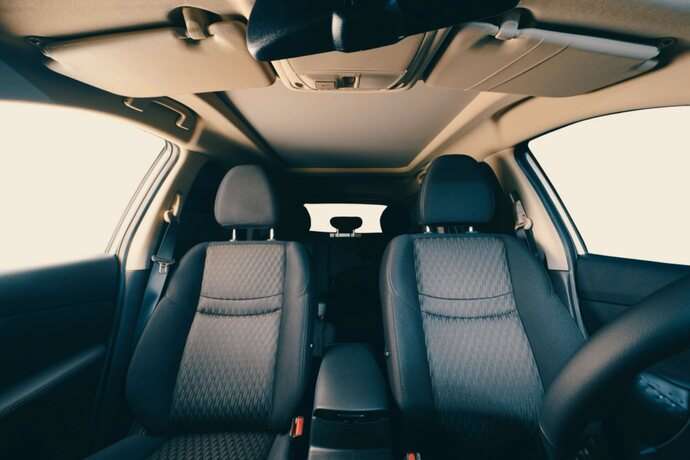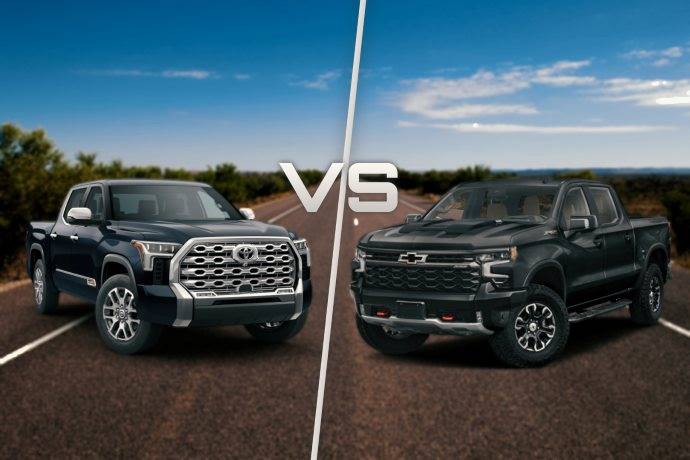The Toyota Tundra and Chevrolet Silverado are both full-sized pickup trucks with great features.
Both of the trucks are popular among the users.
They have both differences and similarities in trims, engines, performance, designs, and many other aspects.
If you are considering buying a full-fledged pickup truck, Tundra and Silverado are great choices.
Then you must know the comparison between the trucks, which will help you choose the right one for you.
To help you make the right choice, I have compared the trucks in 12 distinct categories.
The Toyota Tundra vs Silverado have 12 differences in terms of trim levels, engine specs, performance, transmission, cargo capacity, gas mileage, towing capacity, interior space, safety features, pricing, warranty, and reliability.
1. Tundra Vs Silverado Trims
There are 7 unique grades of the Toyota Tundra: Tundra SR, Tundra Limited, Tundra SR5, Tundra Platinum, Tundra TRD Pro, Tundra 1794 Edition, and Tundra Capstone.
On the other hand, there are 9 trims of the Chevrolet Silverado: Silverado WT, Silverado Custom, Silverado LS, Silverado LT, Silverado Custom Trail Boss, Silverado RST, Silverado LTZ, Silverado High Country, and Silverado LT Trail Boss.
Both Tundra and Silverado trucks have different models. But the Chevrolet Silverado has the most variants.
Also, there are custom trims in Silverado unavailable in the Tundra. So, Silverado will be ahead of Tundra in terms of variety in trims.
2. Tundra Vs Silverado Engine Specs

First-generation Tundras were equipped with 3.4L V6, 4.0L V6, and 4.7L V8 engines.
The first-generation Silverado had 4.3L V6, 4.8L V8, 5.3L V8, and 6.0L V8 engines.
Among the first-generation Tundra and Silverado trucks, the Silverado has more engine options.
Second-generation Tundra trucks had 4.0L V6 VVT-i (2007–2010), 4.0L V6 Dual VVT-i (2011–2013), 4.7L V8 (2007–2009), 4.6L V8 (2010–2019), and 5.7L V8 (2007–2021) engines.
The second generation of Silverados was equipped with 4.3L V6, 4.8L V8, 5.3L V8, 6.0L V8, and 6.2L V8 engines.
Second-generation Tundra and Silverado both have the same number of engine choices.
Third-generation Tundras have 3.4L twin-turbo V6 and 3.4L twin-turbo hybrid V6 engines.
Third-generation Silverados were equipped with LV3 4.3L V6, L83 5.3L V8, LB8 5.3L V8, L86 6.2L V8 EcoTec3 engines, LY6 Vortec 6.0L V8, LML Duramax 6.6L V8, and L5P Duramax 6.6L V8 engines.
Third-generation Tundras have fewer engine options compared to the Silverado.
Toyota Tundra has only three generations, whereas the Chevrolet Silverado has one more generation.
Fourth-generation Silverados have L3B 2.7L turbocharged I4, LV3 4.3L V6, L82 5.3L V8, L84 5.3L V8, L87 6.2L V8, LM2 Duramax 3.0L I6, and LZ0 Duramax 3.0L I6 engines.
Over the years, Toyota has limited the engine varieties, and third-generation Tundras have only two engines.
There are several gas and diesel engine options with the Chevrolet Silverado. But there are no gas-electric hybrid engine options.
Tundra offers V6 engines with a hybrid option, which Silverado lacks. But Silverado trucks have more engine choices compared to Tundras.
Users can have a variety of gas and diesel engines to choose from. So, the Silverado will stay ahead in the engine comparison.
3. Tundra Vs Silverado Performance
The latest basic Toyota Tundra has a 3.5-liter twin-turbocharged V6 engine that produces 380 horsepower and 479 lb-ft of torque.
The latest basic Chevrolet Silverado with a turbocharged 2.7L four-cylinder engine produces 310 horsepower and 430 lb-ft of torque and is available in WT, LT, RST, Custom, and Trail Boss trims.
So, basic Tundra trucks have 70 more horsepower and 49 lb-ft of extra torque.
Silverado with a Turbo Diesel 3.0L V6 engine provides up to 305 horsepower and 495 lb-ft of torque and is available in LT, LTZ, RST, Trail Boss, High Country, and ZR2 trims.
This is another basic engine in the Silverado. The Silverado lacks 5 horsepower but produces 16 lb-ft of torque compared to the Tundra basic engine.
The hybrid 3.5-liter twin-turbocharged V6 engine combined with an electric motor provides up to 437 horsepower and 583 lb-ft of torque.
The 5.3L V8 engine produces 355 horsepower and 383 lb-ft of torque and is available in LT, WT, LTZ, RST, Trail Boss, and High Country trims.
Another 6.2L V8 engine can provide up to 420 horsepower and 460 lb-ft of torque and is available in LTZ, RST, Trail Boss, High Country, and ZR2 trims.
We can see that the Tundra 3.5L twin-turbocharged V6 hybrid engine produces 82 and 17 more horsepower compared to the Silverado 5.3L and 6.2L V8 engines.
Also, the Tundra 3.5L engine provides 200 lb-ft and 123 lb-ft more torque than the Silverado 5.3L and 6.2L engines.
Toyota Tundra can reach 0–60 mph in about 6.2 seconds.
Chevrolet Silverado can reach 0–60 mph in about 6.36 seconds.
So, the Toyota Tundra can reach 0–60 mph 0.16 seconds faster than the Chevrolet Silverado.
Comparing the horsepower, torque, and 0–60 mph time, it is clear that the Toyota Tundra has better performance.
4. Tundra Vs Silverado Transmission

First-generation Tundras were equipped with 5-speed manual, 4-speed automatic, 6-speed manual, and 5-speed automatic transmissions.
The first-generation Silverados had 4-speed automatic and 5-speed manual transmissions.
First-generation Tundras have better transmission options than the Silverado.
Second-generation Tundras had 5-speed automatic, 6-speed automatic, and 6-speed automatic transmissions.
The second generation of Silverados had 4-speed automatic, 4-speed hybrid, 6-speed manual, and 6-speed automatic transmissions.
Both the second-generation Tundra and Silverado have good transmission choices.
The third-generation Toyota Tundra has a 10-speed ECTi Direct Shift automatic transmission system.
Third-generation Silverado trucks were equipped with a 6-speed 6L80 automatic, a 6-speed 6L90 automatic, an 8-speed 8L90 automatic, and a 6-speed Allison 1000 automatic transmission.
Third-generation Tundras have better transmission than Silverado, though Silverados have more transmission variants.
Fourth-generation Chevy Silverado trucks have a 6-speed MYC 6L80 automatic, a 6-speed 6L90 automatic, an 8-speed 8L90 automatic, a 10-speed Hydra-Matic automatic, and a 10-speed Allison 10L1000 automatic transmission system.
Comparing the latest Tundra and Silverado, we can say that the Silverado has better transmission and options.
User reports say that the Toyota Tundra has better handling and control over the transmission than the Silverado.
Tundra is better in the transmission category.
5. Tundra Vs Silverado Payload Capacity
The extended cab offers 6.5 or 8.1 feet, and the crew cab offers 5.5 or 6.5 feet of bed.
The payload capacity of the latest Toyota Tundra is 1485 to 1940 pounds.
The short bed with the crew cab is 5 feet 10 inches. The standard bed is 6 feet 7 inches, with a double cab.
A long 8-foot, 2-inch bed is available with the regular cab. Payload capacity varies with different power trains and ranges from 1870 to 2280 pounds.
The Chevrolet Silverado has 340–385 pounds more payload capacity than the Toyota Tundra. So, Silverado is better at payload capacity.
6. Tundra Vs Silverado Gas Mileage

The gas mileage of the Tundra is rated at 18 mpg in city areas and 24 mpg on highways in 2WD mode.
The combined mileage is 20 mpg when the engine is tuned to a lower output mode.
The gas mileage is 18 mpg in city areas and 23 mpg on highways in 4×2 mode.
The combined mileage is 20 mpg when the engine is tuned to powerful output mode in all trims.
The mileage with the diesel engine in the Silverado is 23 mpg in city areas and 31 mpg on highways. The combined mileage is 26 mpg with the 4×2 mode.
So, the Chevy Silverado has 5 more mpg in the city, 7 more mpg on highways, and overall 6 more mpg compared to the Toyota Tundra in 4×2 mode.
In 4WD mode with the Tundra, the mileage drops to 17 mpg in city areas and 22 mpg on highways.
SR and SR5 trims can provide 17 mpg in cities and 23 mpg on highways. The overall average mileage is 19 mpg.
The i-Force Max hybrid engine slightly improves mileage and performance.
Whereas in 4WD mode with the Silverado, the mileage becomes 22 mpg in the city and 26 mpg on highways. The overall mileage is 24 mpg.
Again, the Silverado has 6 more mpg in city areas, 3 more mpg on the highways, and 5 more mpg overall compared to the Tundra.
Silverado, with the 5.3L V8 engine, provides 15 mpg in city areas and 19 mpg on the highways. The combined mileage is 16 mpg in 4WD mode.
On the other hand, the Silverado, with its 6.2L V8 engine, provides 14 mpg in the city and 20 mpg on highways.
The overall mileage is 18 mpg combined in 4WD mode.
As you can see, the Tundra’s hybrid engine provides good performance and mileage, but the Silverado’s diesel engine outnumbers the Tundra in the gas mileage category. However, the mileage may vary with performance tuning.
7. Tundra Vs Silverado Towing Capacity
The towing capacity of the Toyota Tundra is 12,000 pounds with the i-Force Max hybrid engine and proper equipment.
The towing capacity of the Chevrolet Silverado is 13,300 pounds when the truck is properly equipped.
Both trucks have great towing capacity, but the Silverado leads with 1300 pounds of extra towing capacity compared to the Tundra.
8. Tundra Vs Silverado Interior Space

The Tundra has a spacious interior design. The crew cab and double cab both have 5 seats.
The shoulder room is 65.0 inches, the legroom is 41.2 inches, the hip room is 62.6 inches, and the headroom is 41.0 inches.
The interior cargo capacity is 53.9 to 61.5 cubic feet.
The Silverado has an impressive interior design. The seating capacity is up to six seats.
The front headroom is 43.03 inches, the legroom is 44.53 inches, the shoulder room is 66.02 inches, and the hip room is 61.18 inches.
The interior cargo capacity is around 62.9 cubic feet. The Chevy Silverado has one more seat capacity.
Also, the Silverado has 2.03 inches more headroom, 3.33 inches more legroom, 1.02 inches more shoulder room, and 1.4 more cubic feet of cargo space compared to the Tundra.
The Tundra only has 1.42 inches more hip room compared to the Silverado. So, the Chevrolet Silverado is better in the interior space category.
9. Tundra Vs Silverado Safety Features
The Toyota Tundra has some standard and advanced safety features.
The Toyota Tundra comes with TSS 2.5 driver assistance, which features automatic high beams, pre-collision warning, adaptive cruise control, pedestrian detection, lane-keeping assistance, lane departure warning, automatic brake, rearview camera, blind spot monitoring, road sign assist, etc.
There are also ABS disk brakes, stability, and traction control features. A total of 8 airbags are planted across the cab.
Silverado comes with 6 airbags, daytime running lamps, stability control, a rear view camera, a teen driver feature, and tire pressure monitoring.
The Chevy Safety Assist suite is also present, which includes automatic high beam super cruise control, front collision alert, emergency automatic brake, lane departure warning, distance indicator, pedestrian detection, lane keep assist, etc.
Both of the vehicles have great safety and driver-assist features. So, Tundra and Silverado are both equal in the safety features category.
10. Tundra Vs Silverado Pricing

Pricing of the Tundra base grade SR starts at $39,965, and the SR5 grade starts at $45,500.
Tundra Limited grade pricing starts at $51,855, and Platinum trim starts at $61,755.
The price for the 1794 trim starts at $62,460, and the TRD Pro trim starts at $72,130.
The Capstone grade pricing starts at $78,845, which is the most expensive grade in the Tundra lineup.
Pricing for the Silverado 1500 WT trim starts at $36,800, and the custom trim starts at $43,600.
The pricing of the Custom Trail Boss trim starts at $51,800, and the Silverado LT trim level starts at $48,000.
The price for the RST trim starts at $51,400, and the price for the LT Trail Boss trim starts at $58,000.
LTZ trim pricing starts at $57,200, and High Country trim starts at $62,700.
The most expensive Silverado trim is the ZR2, which starts at $69,900.
Here, the Silverado basic trim is $3,165 less than the basic Tundra trim.
Among the most expensive trims, the Silverado trim is $8,945 less than the Tundra trim.
Silverado is cheaper than the Tundra in the pricing category.
11. Tundra Vs Silverado Warranty
The new Toyota Tundra has a warranty for 3 years or 36,000 miles.
The basic component warranty coverage is for 3 years or 36,000 miles.
The powertrain warranty is for 5 years or 60,000 miles.
The rust-through warranty covers 5 years and unlimited miles.
The emission warranty coverage is up to 10 years, or 150,000 miles, depending on the model and location.
The new Chevrolet Silverado gets a bumper-to-bumper limited warranty for 3 years or 36,000 miles.
The typical powertrain warranty is for 5 years or 60,000 miles.
The emission control warranty is for 15 years or 150,000 miles, depending on the model and location.
Corrosion protection warranty coverage is for 3 years or 36,000 miles.
Rust-through protection warranty coverage is for 6 years or 100,000 miles.
Both pickup trucks have almost the same warranty period, so they are in the same boat regarding warranty coverage.
12. Tundra Vs Silverado Reliability

According to J.D. Power, the reliability score of the Toyota Tundra 2023 model year is 70 out of 100.
Also, Tundra is ranked #4 in the large light-duty pickup truck segment.
According to J.D. Power, the reliability score of the Chevrolet Silverado 2023 model year is 87 out of 100.
Also, Silverado is ranked #3 in the same segment.
Both trucks are reliable, but there is no doubt that Silverado is a bit ahead in terms of reliability.
Final Thoughts
Both trucks fought toe to toe in the safety features, warranty, and reliability segments.
Tundra and Silverado are great trucks to drive, but you must choose between them according to your budget and needs.
The Chevrolet Silverado is a winner in pricing, gas mileage, interior space, power train, and towing capacity, whereas the Toyota Tundra provides powerful engines, transmission, and performance.

